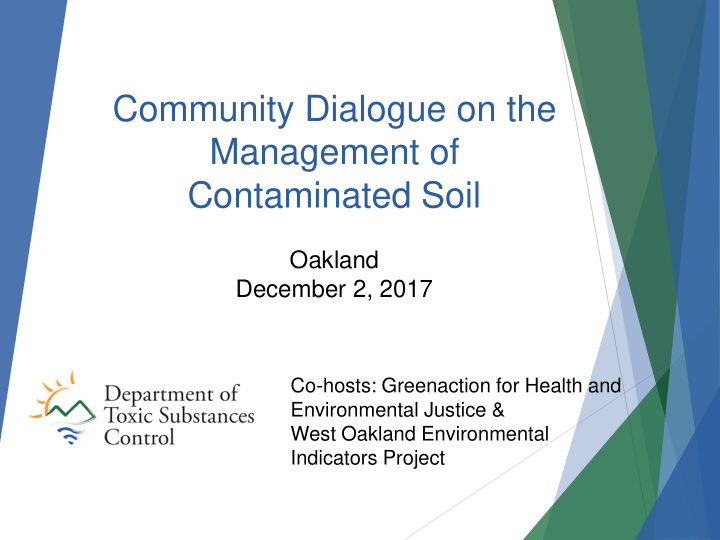



Community Dialogue on the Management of Contaminated Soil Oakland December 2, 2017 Co-hosts: Greenaction for Health and Environmental Justice & West Oakland Environmental Indicators Project
Community Feedback from Meeting #1 and #2 • Transparency/Accessibility • Consistency Community Engagement/Outreach • Modification to Process or Language • • Communication • Decision-making and management • Company/Facility Operations Costs & Resources •
Objectives for Meeting # 3 • Identify a set of shared principles developed by community participants that will help inform DTSC decision-making concerning the disposal and/or treatment of contaminated soils • Develop proposed guidelines for factoring and weighting community input in remediation decisions with an understanding of available remediation technologies.
Next Steps After Today Summary Report and Draft Action Plan 1. (February 2018) Share Outcomes with Communities 2. (Spring 2018) Hold Workshops with DTSC and Communities to 3. Share Information and Program Changes (Winter 2018)
How Much Contaminated Soil is Generated from Site Cleanups? Contaminated Soil generated from Site Cleanup in CA (tons) 900,000 800,000 700,000 600,000 500,000 400,000 300,000 200,000 100,000 Tons - Year
Where is the Soil Going? Disposal In-State Versus Out of State (% of total) 100% 90% 80% 70% 60% 50% 40% 30% 20% 10% 0% 2002 2008 2013 2016 Year In-State Out of State
California Hazardous Waste Landfills 161,335 120,810 tons/year tons/year Tons Clean Harbors, Chem-Waste, Buttonwillow Kettleman City
Out-of-State Landfills Receiving the Most Hazardous Waste from CA (Includes Non-Soil) in 2016 US Ecology, Nevada (530,100 tons), • • East Carbon Development Corp, Utah (480,400 tons), La Paz County – Community • Development Agency, Arizona (66,100 tons). (Hazardous Waste Tracking System)
Contaminated Soil Compared to Other Hazardous Waste Contaminated soil from site clean up compared to other hazardous wastes (% of total and tonnage) 100% 646,363 tons 90% Contaminated soil 80% (35.80%) 70% 60% 50% 40% 1,160, 300 tons Other 30% Hazardous (64.2%) Waste 20% 10% 0% 2016 % of total YEAR
Contaminated Soil from Site Cleanups • Over 600,000 tons in 2016 • Approximately 850 generators • Metals • lead • Semi-volatile organics • polychlorinated biphenyls (PCBs), • pesticides
Remedy Selections Process
Decision Making for Cleanup Projects: National Contingency Plan Criteria • Threshold Criteria - the criteria each alternative must satisfy to be eligible for selection as a potential cleanup option. • Balancing Criteria - technical criteria that form the basis for the detailed analysis of alternatives. Modifying Criteria - criteria that are • assessed during the public comment period.
National Contingency Plan Nine Evaluation Criteria Balancing criteria Threshold criteria Modifying criteria Overall protection of Long-term effectiveness State acceptance (state’s evaluation of draft human health and the and permanence (assessment cleanup plan) environment of residual risk/reliability) Reduction of toxicity, mobility or volume (technical Compliance with evaluation of expected reduction in Applicable or Relevant Community these parameters) and Appropriate acceptance (interested Requirements (ARARs) community’s evaluation and Short-term effectiveness (development of cleanup goals) support, opposition, or (protection of community and questions on draft cleanup workers) plan) Implementability (ability to implement and reliability of technology) Cost (cost of implementation and maintenance)
Options for Cleanup • Immobilization Solidification and stabilization • Containment (landfill, capping) • Extraction • Soil vapor extraction (vacuum) • Thermal desorption (heating) • Soil flushing / washing (separation) • Destruction or alteration • Thermal (oxidation) • • Biological (bioremediation) • Chemical (in situ chemical oxidation)
Handouts and Resources • Technology Screening Matrix (handout) Citizen’s Guides to Cleanup Technologies • “CLU - IN” https://clu-in.org/ • Federal Remediation Technologies • Roundtable https://frtr.gov/ • DTSC Technologies & Remedies Documents • http://www.dtsc.ca.gov/SiteCleanup/PTandR.cfm
Recommend
More recommend